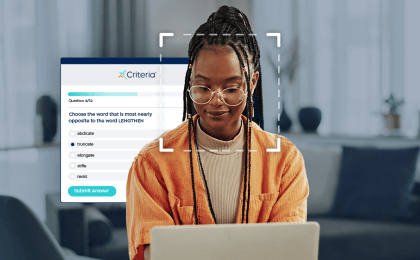The breakneck pace of today’s business environment requires a team that is ready and willing to evolve as needed to rise to the challenge. Continuous learning and on-the-job adaptation isn’t an asset – it’s an absolute necessity.
Whether you’re an HR professional or leading your own team, being able to foster a culture that supports on-the-job learning is crucial to keeping employees engaged at work, while also ensuring the long-term success of your organization.
What is On-the-Job Learning?
Before we can dive into how to foster an environment that supports continuous education at work, it’s important we understand what it is. On-the-job learning is the practice of integrating learning new skills into their daily routine.
It’s a type of internal training that can take many forms:
- Side-by-side mentorship with experienced colleagues
- Peer-to-peer learning that demonstrates new skills
- Formal training programs lead by managers
- One-on-one coaching
- Online certifications and classes
The type of on-the-job training you implement depends on the role itself and your organization’s work environment, so the right approach to internal training is the one that fits best for you and your employees.
So what is the best way to encourage your teams to embrace learning new skills as part of their day-to-day life? We’ve got some strategies to help you promote on-the-job learning at your workplace to make sure your workforce stays ahead of the curve.
Lead by Example
Creating a learning-centric work environment starts at the top. When leadership actively encourages and gets involved in creating learning opportunities or shares their personal experiences, it sets a powerful precedent for the rest of your organization.
The commitment to personal and professional development should be echoed at every level of the company. By actively talking about any courses you’ve signed up for, books or articles you’ve read recently, or new skills you’ve been picking up, you signal to your team that learning at work is encouraged and actively supported. Enthusiasm is contagious, so the more you share about your own on-the-job learning, the more engaged your reports are likely to become.
Create a Supportive Learning Environment
By default, choosing to learn something is a vulnerable position. Create a supportive learning environment by making sure employees feel safe to take risks, ask questions, and admit when they don't know something. Makes sure the lines of communication are wide open and let your team know that this is a place where it’s okay to make mistakes – as long as they are learning from them.
To reinforce this culture, make sure you’re regularly recognizing and celebrating individual achievements, successes, and their learning moments.
Utilize Tailored Learning Tools
You don’t have to bear the responsibility of implementing on-the-job learning on your own. By understanding each employee's individual skill set, team leaders can personalize learning opportunities and align them with both the employee's career aspirations and the organization's needs. Criteria has created assessments to specifically address this need, designed to identify the unique strengths and weaknesses of each person on a team. This targeted approach ensures that on-the-job learning is relevant and engaging at the individual level, making it more likely that the education will resonate with them.
Set Clear Learning Goals
Be SMART when setting goals! Work together with each of your employees to set Specific, Measurable, Achievable, Relevant, and Time-bound (SMART) goals for their on-the-job learning exercises. Confirm that these goals are aligned with both their individual career objectives and the company's overarching goals for the year. Setting clear expectations from the start builds out a clear roadmap for their learning journey that allows employees measure their progress along the way.
Encourage Knowledge Sharing
Foster a culture where sharing knowledge is the norm. Encourage and incentivize team members to teach one another and share insights from their own learning experiences. Whether it’s peer-lead lunch-and-learn sessions, workshops, or informal discussions, give kudos to the members on your team who are taking charge.
Remember, we often learn best by example: when employees see their peers teaching, they become more likely to step up and share their own knowledge with others.
Provide Access to Learning Resources
Your goal is to make it as easy as possible for your team to access the materials they need to learn. Break down the barriers (and excuses!) by providing resources like books, online courses, webinars, and industry publications to your team.
If there is room in the budget, consider subscriptions to online learning platforms where employees can learn at their own pace and choose topics that most interest them. Keeping your employees engaged at work has a positive impact on both productivity and retention numbers, so these subscriptions can be a worthwhile investment for your organization!
Integrate Learning into Work Each Day
To be effective, on-the-job learning needs to be more than just a scheduled activity. It should be part of the daily workflow for your team members. Encourage employees to dedicate a short period of time each day to learning. Whether it’s through the practical application of a new skill, reflection on feedback, or even just reading an article related to their field, this is time well spent.
You can improve daily participation by having members of your team share one thing they learned or skill they worked to improve during a stand-up meeting at the end each week.
Offer Recognition and Incentives
A little recognition goes a long way. Take the time to acknowledge the efforts of team members who are actively engaging in their learning. Some options include verbal praise, awards, or even tangible incentives like bonuses or additional time off for big achievements.
Keep in mind recognition not only motivates individual learners, but it simultaneously demonstrates to the rest of the team that efforts to learn and grow are valued.
Have Career Development Conversations
Keep the learning conversation flowing! Regularly check in with the members of your team to understand how their on-the-job learning is going, discuss their career development, and keep them motivated and inspired to learn.
As a leader at your organization, it is part of your job to understand the aspirations of your employees and get them to see how on-the-job learning enables them to reach their personal and professional goals. By showing a genuine interest in your team’s professional growth, you'll inspire them to stay on top of their continuous education.
Evaluate and Adapt As Needed
Regularly evaluate how effective your of your on-the-job learning initiatives and programs are. Use anonymous surveys and open dialogue in one-on-ones to gather feedback from your team about what is and isn’t working. Stay flexible and ready to adapt your on-the-job learning strategies to better meet the needs of your employees and the organization as needed.
The Importance of Workforce Development through On-the-Job Learning
Active encouragement of on-the-job learning is vital for keeping your teams prepared – not only for the challenges of today, but also ensuring that they are fully equipped for the opportunities of tomorrow. On-the-job learning is the cornerstone of workforce development, and this commitment to continuous improvement has benefits to each individual, department, and the business as a whole.
In an era where industries are constantly evolving, learning and adaptability keeps an organization competitive and nimble in the market. Investing in the development of your workforce not only enhances the skills and knowledge of your employees, but also promotes a resilient, innovative, and forward-thinking organization.
As HR professionals and team leaders, your role in fostering this environment is critical. By implementing the strategies outlined above, you can create a workplace where learning is woven directly into the fabric of your company's culture.





